



“…the futility in this case is underscored by the silly project of bringing forth by mechanical means what nature in any case provides in abundance”1
Visitors to Annette Barbier’s Casualties at Chicago Artists Coalition are confronted by an abundance of dead birds—splayed photographs of birds that nature did not provide any instinct for dealing with gigantic, human-made structures of glass and concrete. Inside these structures are people who have no time to question whether they have any instinct for the same. Barbier’s installation is the intersection of these two sets of animals. Past the short foyer of dead birds, visitors are stopped by a large curtain of feathers without apparent opening. The curtain is lit from behind, flickering. It would be easy to stop here, assuming this giant barrier is the end of the exhibit. In order to progress into the installation, visitors must violate the haptic taboo of the gallery, split the curtain and move forward. Beyond the curtain, the small gallery space is spare. The focus of the installation is an arrangement of kinetic sculptures, sitting on a felt blanket on the ground. Each piece is a rotating wheel of bird feathers, held up by a piece of small gauge PVC pipe. Wires run down the pipe into a single control card. The materials are all apparent but the effect transforms them into minimal bird analogs. With three people in the room, it is easy to see that the feathers rotate faster when approached. With a crowd in the space, the effect is more chaotic and it becomes impossible to discern any relationship between proximity and movement.

Interactivity inevitably removes focus from anything but the interaction, if it is noticed at all. We saw multiple people investigate the piece, focused only on the electronics, trying to figure out how to “make it go.” In Barbier’s use, this is perhaps an intentional distraction, underscoring the disturbing relationship between humans and undomesticated animals in urban environments. The bird analogs spin pointlessly, pathetically, in relation to our nearness and stand in place of a connection to the natural world. With little time for contemplation and a schedule full of assessment, budget cuts, reorganization and perpetual training, the students, staff and faculty of the University of Illinois (where the majority of Barbier’s photos were taken) only encounter birds as they rain down from their impact against the Brutalist architecture.
The “silly project” described in the Danto quote at the beginning of this review describes Paul Klee’s painting Twittering Machine. Mechanical birds perch above a void, feet wrapped permanently around the wire that controls them. They are joyful and terrifying, tongues of exclamation marks and sharp barbs. One wears a spring while another resembles a fly fishing lure. They are unstable, with questionable guy-wires holding them upright. Their perch is a wave on which they will bobble up and down, and perhaps fall, but only if the handle is turned. Barbier’s birds, like Klee’s machine, are a mere mechanical replacements for living beings, precariously perched and only moving within a severely confined environment.
“In my writing I got so interested in fakes that I finally came up with the concept of fake fakes. For example, in Disneyland there are fake birds worked by electric motors which emit caws and shrieks as you pass by them. Suppose some night all of us sneaked into the park with real birds and substituted them for the artificial ones. Imagine the horror the Disneyland officials would feel when they discovered the cruel hoax. Real birds!”2
Where Danto saw an abundance of nature, Philip K. Dick, quoted above, sees the replacement of wildlife with structured wildlife encounters. The artificial birds flutter and respond to our presence but only represent birds as humans imagine them. Barbier’s fake, electric pinwheel birds reduce the illusion to a mockery. The foyer of the installation shows the results of human architecture, inside we are confronted with the futility of seeking a technological solution.
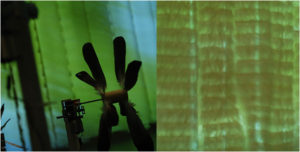
“We are the first generations born into a new and unprecedented age — the age of ecocide. To name it thus is not to presume the outcome, but simply to describe a process which is underway. The ground, the sea, the air, the elemental backdrops to our existence — all these our economics has taken for granted, to be used as a bottomless tip, endlessly able to dilute and disperse the tailings of our extraction, production, consumption.”3
Casualties is not a call to action but a dirge, room silent but for the mechanical sound of small motors. Unfortunately, the human-centered reduction that Barbier’s sculptures outline, a false dichotomy in which we can only “save” or “destroy” nature, is undermined by an associated event. In a catalog insert, we are invited to a workshop on Preventing Bird Strikes. In this two hour workshop, we can learn to “create [our] own DIY devices to help birds avoid collisions with reflective glass surfaces.” The disjunction of human and natural is a much deeper issue and Barbier’s installation poetically makes visible a small intersection in civilization that is incredibly complex, and broken.
_
Images and video courtesy of Annette Barbier
Darko Aleksovski interviews OPA (Slobodanka Stevceska and Denis Saraginovski). OPA (Obsessive Possessive Aggression) is an artistic collaboration, based in Macedonia, whose focus is researching the social, cultural and everyday issues, as well as the ways of looking, thinking and behaving of a certain community in the shifting social and political conditions.
Their project entitled “Bollocks” is a complex and yet very simple interactive installation, made out of a video/image projection in a room in which only one viewer at a time is allowed to see it. The project was first shown at the Authorial Through The Appearance 3 exhibition in Veles, Macedonia (2009). Then it was modified in a second version entitled as “Bollocks for Everybody” for the Small Gallery in Skopje, Macedonia. After that the project was shown at the fifth edition of the AKTO- Festival for Contemporary Arts (2010) where it was awarded with the annual Dragisa Nanevski Award for interdisciplinary achievments. The project was also shown in Studio Golo Brdo, Rovinjsko Selo, Croatia (2011).
Darko Aleksovski: “Bollocks” is a project which was shown on several occasions in art festivals and group exhibitions. Once it was exhibited as “Bollocks for Everybody!”. Can you tell us what was first: its idea, or its title?
OPA: Our initial idea was to relate one specific phenomenon of the Macedonian cultural life: much stronger “gravitation” than in the other parts of the world. It means everything is much harder here, for every single “motion” connected to arts and culture, you need several times more energy compared to other places. It could be because of our institutions, or the specific mentality, or the geographical, political and economic situation of the country – it is a matter of larger analyses. However we didn’t have intention to speak about those reasons into this work, but simply to remind of the existence of the issue. That’s why the work (visually) is about seating and waiting. In the video-image we sit and endlessly wait for something to happen. And when the spectator enters, (s)he triggers the sensor and we both leave the image. So the spectator gets nothing and sees an image of two empty chairs. In the Macedonian colloquial speech you would say the spectator gets “tashak” or “tashaci” (Macedonian: ташак, ташаци). So that is the original title of the work – “Tashaci”, given when the work was completely shaped. “Bollocks” is the best English translation that we could find, but it still doesn’t represent the expression best.
And “Bollocks for Everybody” is the title of the second version of the work, created for the windows of Mala Galerija (The Small Gallery) located in a shopping mall in Skopje.
For our solo presentation in Mala Galerija, we made two different settings of the same work: (1) On the windows of the gallery there was a projected video-image of two empty chairs. When the casual passers by trigger the sensor, our figures were entering the video-image facing the spectator. (2) But inside the gallery we installed the original version of the work, which was intended for the regular visitors of the cultural events, this time invited for the official finissage of the exhibition.
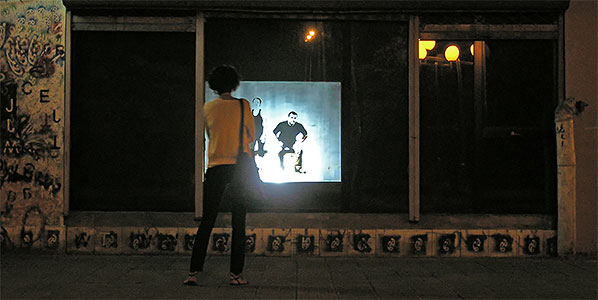
DA: Is the project primarily concerned with the general Macedonian cultural context, or it is dealing with more universal issues?
OPA: We could say that this work is emanated from these local issues, thus it is concerned with the Macedonian cultural context. Translated into the general context it speaks more about the art system, the expectations of the audience, the immateriality of the artwork, about the things that we always miss out, the absurdity, the nothingness…
DA: On one occasion, you say that the inspirational thought about the project is: ‘Art is always in another place’. Does the project speak of ignorant art or ignorant audience?
OPA: It is more about the expectations. About the expectations of where the “real” art should be, what should it look like, what is the art like in other places (always better than our), while we miss the things that are happening (or could happen) here, in front of us. One other interesting interpretation of this thought is that the art is happening during the process of creation. The artist touches it for a moment, and everything that we see as an exhibited object is only a document, a trace of the existence of the art, a way for the artist to share with the rest of the world what (s)he had experienced.
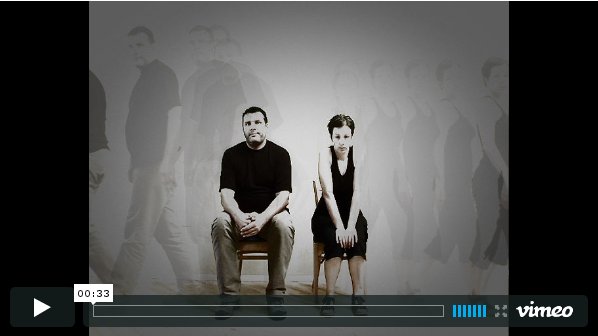
DA: Do you think interactive art is one of the easiest ways to communicate with the audience today?
OPA: It is one of the ways, but it doesn’t have to be the only or the easiest way. Anyway the art today should be in the things that surround us, or incorporated into our everyday life. It should reach us other ways than just through the galleries. It should try to surprise us, confuse us, shake our solid image of the world and make us think and reconsider our attitudes.
DA: How do you feel about joking with/ in art? Do you think a joke in an artwork should be considered a serious statement?
OPA: Humor is one very helpful tool to address the social and the political issues, or the things that bother you and the things that hurt you. It doesn’t mean that if the work involves humor it doesn’t have a serious statement. Thus it is often present in our work. One other tool that we often use in our work is entertainment. Often it is the first thing that catches the audience, it “steals” their time and attention, and than through it we try to convey our message.
DA: Absence is something one finds in many of your works. The absence of connection with reality, absence of objects, even absence of a final artwork, or project. What kind of presence do you think this absence refers to?
OPA: It is really exciting if you succeed, while acting with the art language, to make an artwork that would be communicated but not perceived as an artwork at first. In that case, the work has a direct communication with the audience, not burdened with the fact that art has “special place” in our society. It becomes a kind of subversion of the everyday life – you can experience art without knowing what’s in front of you, yet the situation you have experienced, is an artwork. What we do in our work is about creating “situations”, or often creating the artwork together with our audience. Whether this artwork is either immaterial or difficult to possess.
Videogame appropriation in contemporary art: Space Invaders
Tomohiro Nishikado’s classic videogame Space Invaders from 1978 can be seen as a metaphor for the Cold War and the fears for an approaching nuclear war. An extraterrestrial army are marching rhythmic and increasingly closer to Earth. Only a lone cannon stands between the intergalactic monsters and the total annihilation of mankind. The lonely hero struggling against evil is a theme that we recognise from myths, films and books. Space Invaders with its clear and pedagogical symbolic language has inspired several contemporary artists to describe the eternal struggle between good and evil in our time.
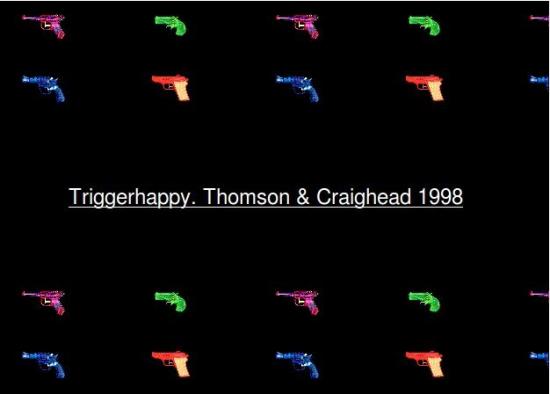
In the British artists Thomson & Craighead version Triggerhapppy the enemy aliens are replaced with quotes taken from the French philosopher Michael Foucault’s essay “What is an author?” “Triggerhappy” is a work that explores the relationship between hyper-text, author and reader. What is a writer, or rather, who is the artist when we are dealing with interactive art in the form of a videogame? Is it Tomohiro Nishikado who created the original game or is it Thomson & Craighead that have modified the game or the player that are playing the game or maybe the computer that creates and interprets the text (the code) that make the game appear on the screen?

After the 11th of September the world suddenly saw a new major enemy, international terrorism. In a modernized version of “Space Invaders”, the artist Douglas Edric Stanely located the scenario in the game to the Twin Towers in New York, which was destroyed during the terrorist attack on 11th September 2001. In Stanley’s version titled the invaders, you have to fight against the hostile aliens before they completely destroy the two towers. The classic struggle between good and evil continues, the game concept is the same as in the original but the scenario and the metaphoric meaning of the aliens has changed.
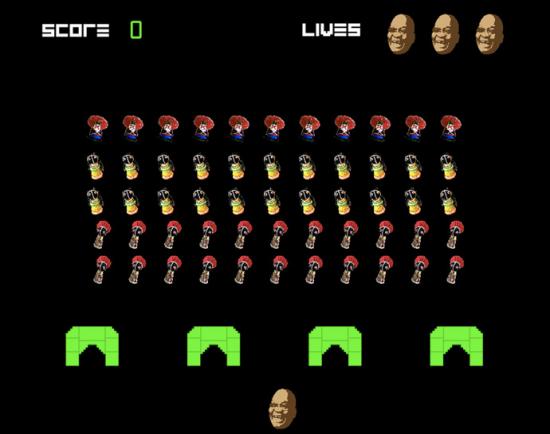
The struggle between good and evil can also be found in other areas of our society, for example in class and gender struggle. In the South African photojournalist Nadine Hutton’s version Skirt-Invaders the main character in the game is Jacob Zuma, South African president since 2009. Zuma has been quite controversial because he is a polygamist and has expressed his doubt about the dangers of AIDS. In the game Zuma you have to shoot down a never-ending stream of virgins from the Zulu tribe. Will the president succeed to shoot down any threatening scandals before they land on the ground? Hutton’s work is an example how a well-known videogame can be used for political purposes and be both entertaining and still very critically at the same time.
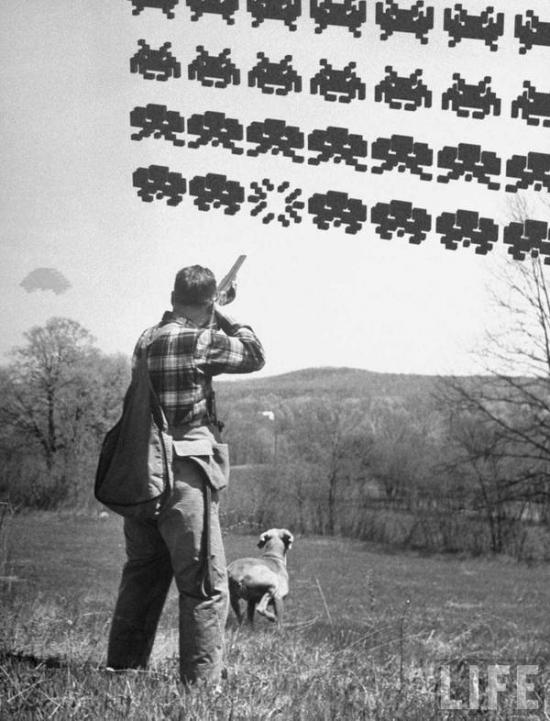
The term mash-up, which is frequently used today, could be described as a form of digital collage. Ryan Sneider has created mash-ups by combining images from various sources, in this case photographs from Life magazine’s archives and videogames. The photomontage Duck Hunt / Space Invader shows a bird hunter with a dog, but it is not birds the hunter aims for, instead it is the famous monsters from the “Space Invaders”. Those who played videogames in the 70 – and 80’s will probably remember the game “Duck Hunt”, where you could shoot ducks that flew up out of the reeds and your faithful dog then ran to fetch them. Sneider has combined the two game ideas, one composed of a photo of a true hunter with a dog and the second of digital graphics from the videogame “Space Invaders”. The work discusses the boundaries between the real and digital world. What will happen when these two worlds become more integrated and the borders are increasingly blurred?
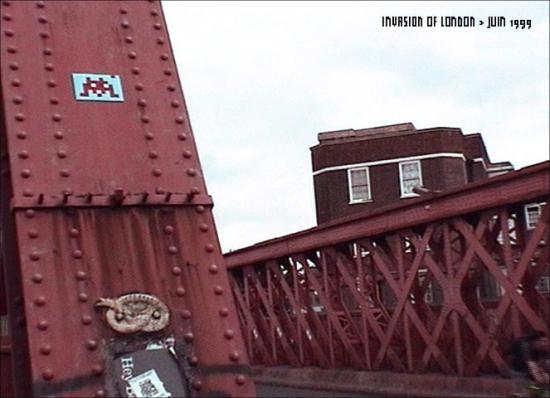

Finally we have to mention the artist, who personifies the game, the French street artist who hides behind the pseudonym Space Invader. His main art project consists of invading various cities around the world and putting up small mosaics of characters from videogames as “Space Invader”. For each successful invasion, he collects points, and the whole art project is described on his website as a reality game. Like other forms of street art “Space Invader” is an ongoing battle about the public space. With help of popular culture Space Invader tries to infiltrate the commercial forces that almost have total monopoly on the imagery that appears in our public spaces. The aliens, in form of small mosaics, become a force that can not be defeated when they are spreading all over the world. A important part of the game “Space Invaders” is that you cannot win, you can certainly come to the high score list, but you can never defeat the aliens, they are instead coming in faster and faster each time they are shot down. It’s obviously a dystopian world view we meet in the videogame, but if we look at it from the artist Space Invaders point of view, it’s rather something positive. The art is a force that will not be stopped. The invasion has just begun and the struggle between good and evil continues…
Videogame appropriation in contemporary art: Pong. Part 1 by Mathias Jansson.
Videogame appropriation in contemporary art: Tetris. Part 2 by Mathias Jansson.
The legend says it was when the Japanese game developer Toru Iwatani took a slice of his pizza that the yellow game character Pac-Man appeared before him. In Pac-Man, we find a restless character hunting around in life’s mazes constantly seeking for pills to satisfy his insatiable desire. Meanwhile the ghosts of anxiety are tracking him down. What many players don’t realize are that the game also contains an unanswered philosophical-existential question. Where is actually Pac-Man for the short period of time when he escapes into the left or right end of the maze and after a short time pop up on the other side of the maze?
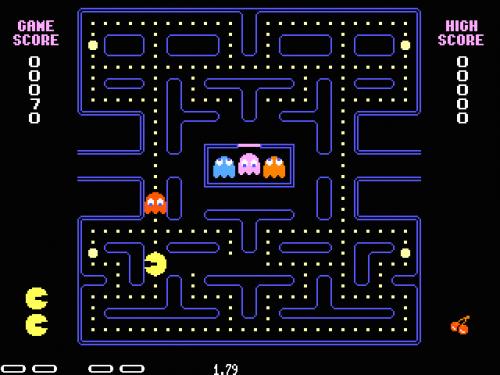
In Martina Kellner’s work “Pac-Man Time Out”, which was showed at the exhibition A MAZE in Berlin 2009, Kellner had created short video clips that investigated what Pac-Man actually did in the short time he was away from the monitor. In one clip, we find him at the airport queue with Ms. Pac-Man ready to board. Perhaps they are planning to take a holiday away from the busy videogame environment? One thing is for sure, Pac-Man does no appear in contemporary art as much as his colleagues from other classic games as Space Invader, Pong and Super Mario.
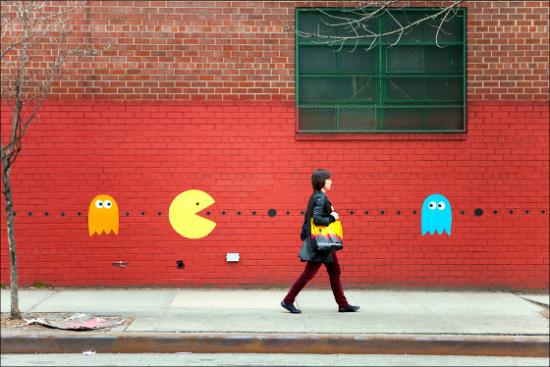
Like many 8-bit characters Pac-Man is well represented in street art and design. For example the American street artist Katie Sokoler staged a real Pac-Man game in her quarters. But it is quite unusual with installations, machinima or Art Games in which Pac-Man has the lead role. This is a bit odd considering how famous Pac-Man is among the general public. The French artist François Escuillie has even created a paleontological reconstruction of Pac-Man’s skull and the Swedish artist Johan Lofgren has in his new colour series “Confessions of a Color-Eater” taken with the colour “Ms. Pac -Man-yellow “, but despite this there are few interactive artworks based on Pac-Man.
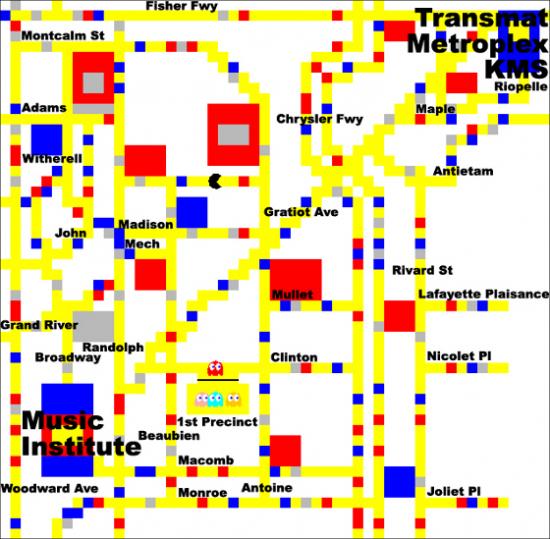
Two exceptions are in any case worth highlighting: the “Pac-Mondrian” and “Eggregore”. “Pac-Mondrian” was created in its first version in 2002 by the Canadian artist group, Price Budgets Boys and is described as a mix of Piet Mondrian, Pac-Man and Boggie Woggie music. The board consists of Piet Mondrian’s painting “Broadway Boogie Woogie” (1942-43), which in its turn is inspired by Manhattan’s street grid and boogie woogie music. The videogame works with the same principle as a normal Pac-Man game except that the maze is a painting by Piet Mondrian. Price Budget Boys have also created three sequels: “Detroit Techno” (2005), “Tokyo Techno” (2006) and “Toronto Techno” (2006). The labyrinths in the new versions are created by stylized street grid from each city, executed in the style of Piet Mondrian. And in the name of equality, you play as Ms.Pac-Man in these versions. For those who have followed previous articles in this series, will recognize that there is a similarity between “Pac-Mondrian” and the Danish artist Andre Vistis works “PONGdrian v1.0”, in which Vistis combined the videogame PONG with Mondrian’s paintings.
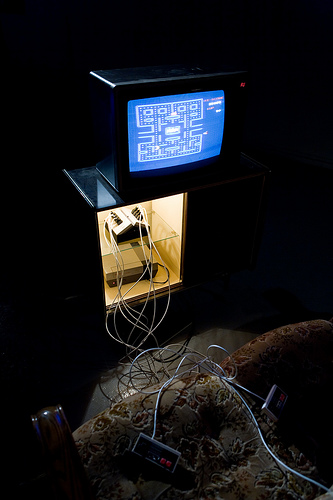
Antonin Fourneau & Manuel Braun’s work “Eggregore” is a social video game in which eight players, each with its own control will try to collaborate and steer Pac-Man through the maze. It may sound like an old teamwork workshop with a twist. Eight wills and strategies must collaborate to succeed with the mission. “Eggregore” is a Greek word which is associated with occultism and means a collective mind. The question that Fourneau and Braun is asking is: Can multiple individual game strategies together create a stronger and better collective player or will it just be chaos when the different games strategies are pulling in different directions? In the video game world, there are many examples of online worlds like World of Warcraft, where player successfully work together in clans or guilds in order to achieve higher goals in the game. It has even become an asset in your CV to show that you have played World of Warcraft and that you can lead and work together with other players to achieve different goals. Pac-Man, however, seems to be a rather greedy individualist who only thinks of himself in the video game world. And perhaps it is this self-absorption with himself taht prevents the game from breaking through as a major theme in contemporary Game Art?
Pac-Mondrian:
http://www.pbfb.ca/pac-mondrian/
Eggregore:
http://liftconference.com/eggregor8
Videogame appropriation in contemporary art: Pong. Part 1 by Mathias Jansson.
Videogame appropriation in contemporary art: Tetris. Part 2 by Mathias Jansson.
Videogame appropriation in contemporary art: Space Invaders. Part 3 by Mathias Jansson
In the second part of classic videogames that have inspired contemporary artists, we take a closer look at a game that the Cubists probably would have worshiped. Tetris was created in 1984 and then released officially in 1985 by the Russian programmer Alexey Pajitnov. In Tetris you have to move and rotate seven different combinations of blocks as they fall into a well. The blocks are called tetrominos and are made of four squares. The goal is to fit the different geometric shapes so that as little empty space as possible remains in the bottom of the well. Tetris is a puzzle game for people who like compact living, and who see it as a sport to pack economically to the holiday.
In contemporary art you can find three main approaches how artists have used Tetris. The Swedish artist Michael Johansson is a good example of the first approach. He has used the basic idea of Tetris to stack objects with different colors and shape. Johansson works with site-specific installations, in which he collects and stacks objects from the near surroundings in perfect symmetry with no spaces. The installations are called Tetris, which is fitting since they are strongly reminiscent of the game.

“For me creating works by stacking and organizing ordinary objects is very much about putting things we all recognize from a certain situation into a new context, and by this altering their meaning. And I think for me the most fascinating thing with the Tetris-effect is the fusion of two different worlds, that something you recognize from the world of the videogame merges into the real life as well, and makes you step out from your daily routine and look at things in a different way.” says Johansson in an interview at Gamescenes.org
Like many other classical videogames, Tetris has been used a lot in public spaces as in graffiti, mosaics and posters on facades and in subways etc. In Sydney, Australia, artists Ella Barclay, Adrianne Tasker, Ben Backhouse and Kelly Robson in 2008 at an exhibition at Gaffa Gallery created an installation where they placed giant illuminated Tetris Blocks in a narrow alley. It looked exactly as if the blocks had fallen from the sky, but the alley had been too narrow so the blocks were stuck halfway down.
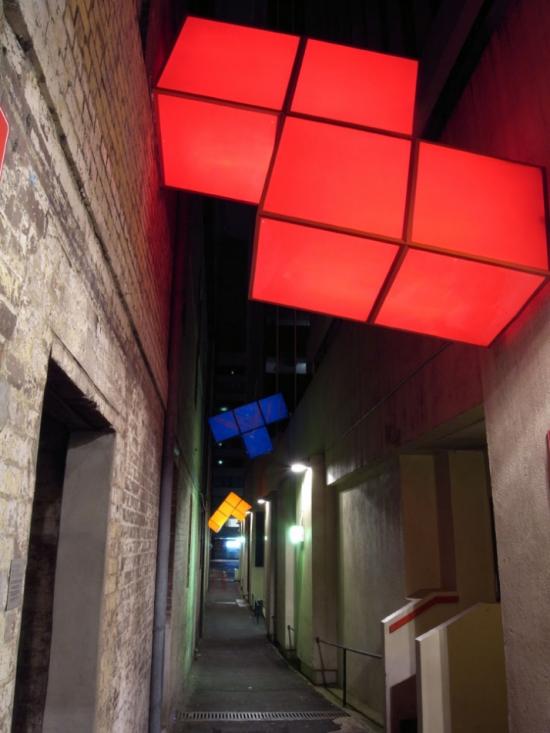
The second approach is to move Tetris out from the exhibition room into public spaces and sometimes also create interactive and social art. The artist group Blinkenlights, who are known for transforming large skyscrapers into interactive screens, on various occasions making it possible for the passing public by to play Pong or Tetris on a skyscraper using a mobile phone. In 2002 they made the installation Arcade, which turned one of the skyscrapers in the Bibliotheque Nationale de France in Paris to a giant screen showing various animations, where a passersby could also play arcade games like Tetris.
The artist group Lummo (Carles Gutierrez, Javier Lloret, Mar Canet & JordiPuig) created in Madrid in early 2010, a Tetris game in which four people have to cooperate to play it. The first step for the participations was to create the Tetris blocks and after that they had to work together to place on right position in the well which was projected on a wall. In Both cases, Blinkenlights and Lummo are creating public meeting places with social interaction where the videogame is used as an interface.
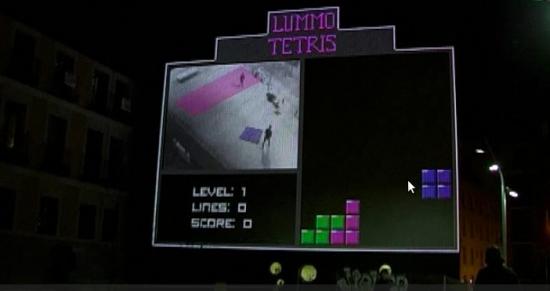
The third approach is changing the game itself and creates new versions of the game which discuss the game idea. The artist group version [url=http://www.tetris1d.org/]1d Tetris[/url], is a one-dimensional Tetris where the blocks consist of four vertical squares falling into a well that is just one block wide. Since the blocks always fill the well the players do not have to do anything to score points. The basic idea of the falling blocks still remains in the game, but in a one-dimensional world there is no longer any difficulty, the game is reduced to a very monotonous and predictable puzzle game.
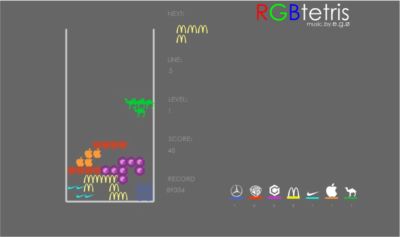
In First Person Tetris the artist David Kraftsow combines the perspective from the popular first person shooter genre (used in war and action games) with the ordinary puzzle game. In Kraftsows variant you see the game from a first person perspective so when you spin the blocks, it is not the individual blocks that are spinning around but instead the whole screen. Just by using a new perspective in the game has Kraftsow created a whole new experience of Tetris. Mauro Ceolin, who has spent many years focusing on the modern emblems on the Internet. In works such as RGBTetris and RGBInvaders he replaces the game’s graphics with contemporary icons and logos. In RGBTetris the blocks that fall down the well are exchanged with logos from Camel, McDonalds, Nike and Mercedes.
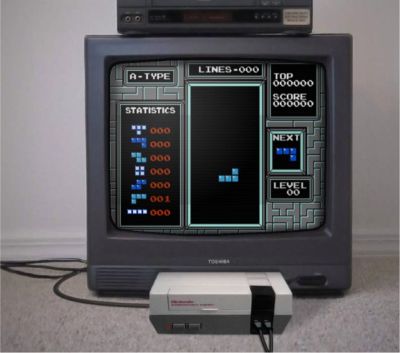
The most interesting and most independent among the playable Tetris versions that I have found are made by the Swedish artist Ida Roden. In Composition Grid she has combined her interest in drawing with Tetris. The player can play a game and in the same time create a unique drawing by rotating and changing one of the 216 different creatures that Roden has created, with the Tetris blocks as model. The player can then choose to print out their own game plan with the artist’s signature, and in that way have a unique work of art in there possession.
Tetris, this two-dimensional version of Rubik’s Cube, seems to create a lot of room for artistic experimentation. It just needs some simple changes, or new perspectives, to create a new and interesting interpretations of the game.
Videogame appropriation in contemporary art: Pong. Part 1 by Mathias Jansson.
Some of these new Tetris games can be found at these addresses:
www.rgbproject.com/RGBtetris/RGBtetris.swf
www.tetris1d.org
www.firstpersontetris.com
www.idaroden.com/composition.html
Between July 27th and August 29th, 2010, the eleventh edition of the FILE festival is taking place in Sao Paulo (Brazil), at several locations along the popular Paulista Avenue. After a decade of existence, this veteran festival, which spreads over several cities in Brazil (including Rio de Janeiro and Porto Alegre) as well as other international locations, has introduced for the first time its own award: the FILE PRIX LUX. With a total amount of approximately 120,000 euros, distributed in three categories, the prize is unprecedented in the continent and has received, on this first edition, 1,235 registrations from 44 countries.
Yet this award is not the only remarkable aspect of this year’s festival, which stands out for being particularly accessible to the general public. On the one hand, the exhibitions, performances and workshops as well as the symposium have no entrance fees, and therefore there have been many visitors, most of all young people who line up every day to experience the interactive installations at the FIESP-Ruth Cardoso Cultural Centre. On the other hand, the festival organizers, Ricardo Barreto and Paula Perissinotto, have developed this year a project that takes digital art to the Paulista Avenue by placing several interactive artworks at different locations in the public space. Finally, even the FILE PRIX LUX has been open to the interaction with the public by introducing a popular vote category and an online voting system which was accessible between May and June. This openness sets a good example of how media art festivals can engage the general public to approach this somewhat ignored form of art.
In general terms, the award categories at media art festivals have been subject to change as the creative uses of technology evolved during the last decades. The FILE PRIX LUX has the advantage of being created at a time in which it can be relatively safe to set up a few broad categories that cover most of the forms of combining art and technology. Only three categories have been established: Interactive Art (which usually refers to objects and installations that respond to inputs from the viewer/s), Digital Language (related to the festival’s title and which embraces any artwork that deals with language, narrative, code or text in a generative or interactive manner) and Electronic Sonority (the category assigned to any artwork in which the production or manipulation of sound is a key element). These three categories prove to be comprehensive, as shown by the diversity of the projects distinguished with a prize or an honorary mention: immersive interactive installations, musical performances, urban interventions, bioart pieces, a collectively created machinima movie and even an iPhone app are among this year’s FILE PRIX LUX awardees.
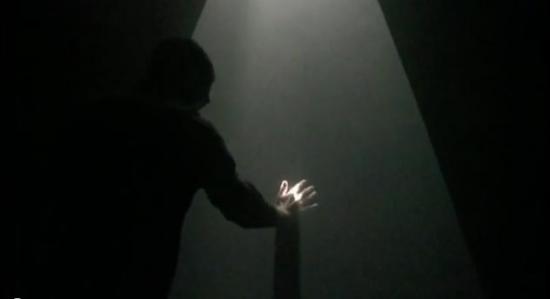
In the Interactive Art category, the winners are Ernesto Klar for Relational Lights (1st prize) and Kurt Henschläger for Zee (2nd prize). Both present immersive environments in which light and space are key elements, although the interaction is totally different. Klar’s work invites the viewer to interact with two projected geometric drawings inspired by the work of Lygia Clark. In a hazy dark room, the viewer sees two T-shaped projections of white light on the ground, which form a three-dimensional space which reacts to the visitor’s presence. The interaction is playful and really beautiful in its simplicity, whilst also limited in time: after a few minutes, the projections suddenly stop reacting to the user’s movements and reconfigure themselves in a new shape. This abrupt interruption is consciously introduced by the artist in order to remind the viewer that the artwork has a life of its own. In contrast, Henschläger’s Zee takes place mostly in the mind of an audience exposed to an overdose of audiovisual stimuli in a foggy room. Continuing the experience of his acclaimed performance FEED, this time the artist allows the viewer to walk around the space and have a more meditative sensory experience.
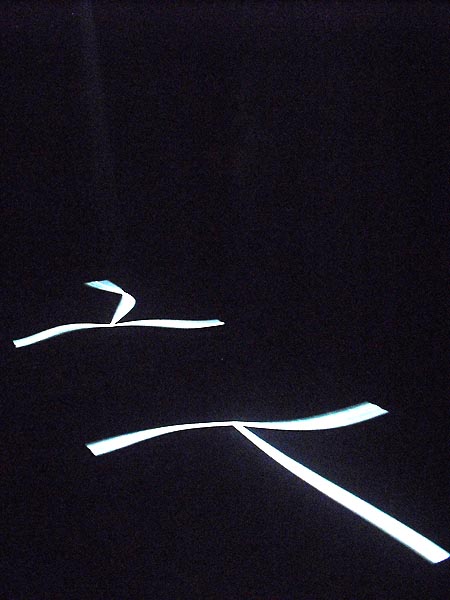
The Electronic Sonority category has brought together several outstanding works, among which Jaime E. Oliver’s Silent Percussion Project and TERMINALBEACH’s Heartchamber Orchestra have been distinguished with the 1st and 2nd prize, respectively. In both projects the human body is incorporated in a novel form in the creation of music, the sound being produced, moreover, not simply by direct inputs but by complex interactions in a constant flow of data. Oliver’s instruments convert the shapes created by the performer’s hands into streams of data that generate, in turn, different sounds. These sounds are not always the same, as could be the case in a traditional instrument, but are changed by the variables established in previous interactions. Thus, Oliver does not simply create a new form of interacting with an instrument but rather a new form of creating music. In a similar way, the [i]Heartchamber Orchestra[/i] project developed by TERMINALBEACH (Erich Berger and Peter Votava) explores a form of creating music based on a feedback loop in which the performers are writing and following the score at the same time. As the artists state, in their project “the music literally comes from the heart”: a network of 12 independent sensors record the heartbeats of the musicians in an orchestra and sends the data to a software that generates a musical score in real time. The musicians play the score as it is displayed on the laptops in front of them, while their heartbeats set the notes in a continuous cycle in which music and performer constantly influence each other.
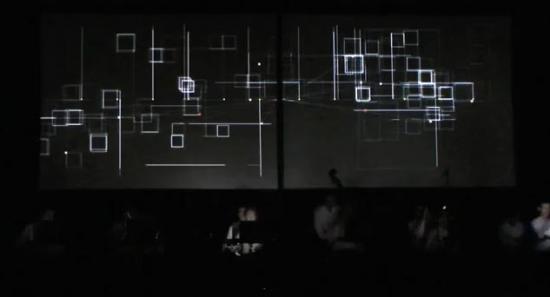
Digital Language is certainly the broadest category of this FILE PRIX LUX, its awardees being quite dissimilar in the formats they use and the objectives of their respective projects. The organizers define this category as including “all research and experiments in the ambit of the multiple disciplines that use digital media”, and the winners exemplify how diverse these disciplines can be. The 1st prize winner, Tardigotchi by the artists collective SWAMP (Douglas Easterly, Matt Kenyon and Tiago Rorke) is a bioart project that sets a critical comparison between artificial and real life. A nicely designed, steam punk-inspired device hosts, on the one hand, a tardigrade, a microorganism measuring half a millimeter in length, along with a robot arm that injects a substance that feeds the creature and a heating lamp that provides warmth. On the other hand, a digital display shows the virtual avatar of this tardigrade, with which the user can interact. Humorously referencing the popular Tamagotchi toy, the artists create a link between the avatar and the real creature: when the user presses the button to feed the avatar, the device inserts real food in the environment of the tardigrade; when an email is sent to the digital creature, a heating lamp gives warmth to the microorganism. Thus, interacting with the virtual pet has consequences in a real living being. This brings our attention into what we can consider alive and how we emotionally attach to artificial creatures while at the same time we undervalue the existence of other living beings. On a different approach, the 2nd prize winner, Hi! A Real Human Interface, by the collective Multitouch Barcelona (Dani Armengol, Roger Pujol, Xavier Vilar and Pol Pla), proposes a more human relationship with technology. A video presents the concept developed by this interaction design group of a different GUI in which a real person is displayed as impersonating the computer. Common interface elements are replaced by handmade physical objects which remind the aesthetics of a video by Michel Gondry. The result is a playful form of interaction in which simple operations such as checking email or upgrading the operating system are shown as actions carried on with real objects by a person inside a box. The proposal is engaging and certainly sets a departure from the old desktop concept, yet it remains unsure to what extend this type of interaction can be applied in a real operating system.
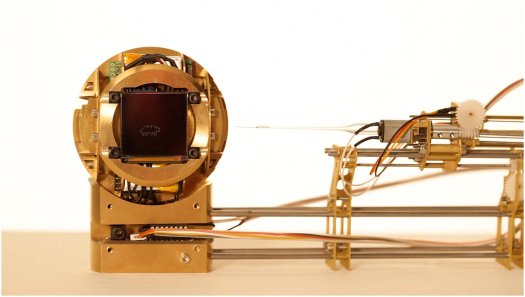
The works that obtained a Vesper statuette (symbol of the FILE PRIX LUX award) along with the also outstanding Honorary Mentions are exhibited at the FIESP-Ruth Cardoso Cultural Centre in a group show that also includes FILE Media Art, a selection of more than 70 works that can be accessed on several computers, as well as a selection of videogames and machinima films. The exhibition is thus richer in content than it would seem at first sight, as the space is divided in numerous sections that conceal several installations which demand (as usual) almost total obscurity. The artworks are well presented, although at times the sound from one installation invades the others, and there are no wall labels that inform the viewer about the concept of the piece or the way to interact with it. The latter, much-discussed issue is quite important, since the info-trainers cannot explain the artworks to every visitor, and quite often this entails that some people may not interact with the pieces or worse, start smashing buttons or interfering projections blindly in the hope of modifying them. Despite this fact, the exhibition has proven to be very successful during the first week of the festival, with a steady flow of visitors who showed a profound interest in the artworks.

A part of the exhibition is devoted to the FILE MACHINIMA section, curated by Fernanda Alburquerque, who selected over 40 works. Among these is the award winner in the Popular Vote category, War of Internet Addiction, by Corndog and the Oil Tiger Machinima Team from China, a 64-minute movie collectively created by players in the MMORPG War of Warcraft. More than mere entertainment, this film has been created as a form of protest against the Chinese authorities’ attempt to control the access and commercial benefits derived from the WoW game, which is extremely popular in the country. The film has had 10 million views since January 2010 and despite being available only in Chinese, it has been the favorite work of those who participated in the online voting system of the FILE PRIX LUX. Besides this feature film, other short films explore the possibilities of building narratives in virtual environments such as Second Life and videogames such as Half Life 2, Eve Online or Shadow of the Colossus.
In addition to the main exhibition, the FIESP Cultural Centre hosts a series of performances and screenings. Under the title Hypersonica, the festival presented a series of digital music performances, among which where the two winners of the FILE PRIX LUX in the Electronic Sonority category. FILE DOCUMENTA, curated by Eric Marke, offers in its 5th edition a selection of “rare and new” documentary films, among which Andreas Johnsen’s Good Copy Bad Copy, an interesting exploration of the conflicts between remix artists and copyright owners, or Robert Baca’s Welcome to Macintosh, which records the first years of the history of Apple Computers.
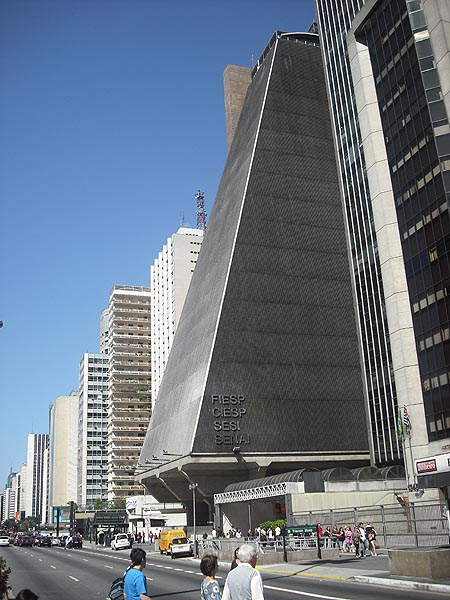
The symposium, hosted by the Instituto Cervantes in Sao Paulo, gathered several experts and artists who presented their explorations in the theory and practice of media art. Among the most interesting contributions were the presentation of Prof. Espen Aarseth on the aesthetics of ludo-narrative software, and the colloquy of South American digital art, in which Raquel Renno (Brazil), Jorge Hernandez, Ricardo Vega (Chile) and Vicky Messi (Argentina) discussed the current developments in the media art scene in the South Cone.
Alongside the FILE PRIX LUX, the most outstanding feature of the present edition of the festival is FILE PAI (Paulista Avenida Interactiva), which takes several interactive artworks to the public spaces in the Paulista Avenue. Interactive art offers the possibility of bringing art to the public space in a more efficient and dynamic form than what is usually known as “public art”. As Ricardo Barreto states: “the public environment is not something empty, aseptic and dead, as is the old white cube; on the contrary, it is an environment teeming with life, with multiple interests and multiple behaviors”. Interactive art integrates itself into this environment and is much more apt to relate to a public that is now willing to take an active role. The organizers of the FILE festival have distributed twelve interactive artworks along the Paulista Avenue, at subway stations, inside shopping malls, and even in a bus. The selected artworks include, among others, videogames such as Patrick Smith’s Windosill or the celebrated games of That Game Company, Flower and Flow; VR/Urban’s SMSlingshot, an urban intervention project that allows users to write a message in a custom-made slingshot that incorporates a screen and a keyboard and then send the message to a wall, where it is displayed as a virtual graffiti; Karolina Sobecka’s Sniff, an interactive projection in which a virtual dog reacts to the presence of passersby; the installations of Rejane Cantoni and Leonardo Crescenti Piso and Infinito ao Cubo, which attracted a large number of people, and the sound piece Omnibusonia Paulista by Vanderlei Lucentini, which is played in a bus as it moves along the avenue, interacting with several points in the itinerary and thus generating a new set of sounds in every trip. These works reveal the possibilities of integrating interactive art in the public space, to the point that, as Ricardo Barreto indicates, “the new paradigm of public art will be the interactive city”. The busy Paulista Avenue is certainly a good location for the creation of an emerging, interactive city.

In this 11th edition, the FILE festival has achieved a state of maturity. The FILE PRIX LUX, FILE PAI and an estimated 25,000 visitors to date support its claim of being the largest festival of its kind in Latin America, and a steady event that places Brazil in the map of the international digital art scene. In a tightly interconnected world, each region is a node: there isn’t a center and a periphery anymore, there are no colonies. FILE exemplifies how a region can become a powerful node in this network by promoting the most recent developments in art and technology, avoiding obsolete distinctions between North and South and becoming a point of development for the future stages of our digital culture.
Featured image: F.A.T. Lab (Free Art and Technology Lab) were found causing trouble at the Transmediale.10 this year.
An interesting outsider project at Transmediale.10 this year, was F.A.T. Lab (Free Art and Technology Lab). A collective of artists, engineers, scientists, lawyers, musicians and trouble-makers who have been working together for two years, on the intersections of Pop culture and Open source. Their stapline describes them as “An organization who is dedicated to enriching the public domain through the research and development of creative technologies and media”. Beware, they love using the word ‘Fuck’. A lot! Which means they are cool, and some you grown ups may feel slightly unnerved by their over generous outpouring of flippant explitives, but the kids out there just love it!
You can read an explanation of their work in the about section on their website, and view a video presenting some of their ideas and works. With a simple rap base with nasty yellow and pink colors, it could be considered as a joke. Perhaps, to some degree it is, but at another level they are playing around with social contexts of the Internet culture’s, presumptions and acceptance of things. Through an omnipresent ludic approach they reuse what is given to us all with a contemporary pop attitude – showing us the many contradictions from these given systems. Proposing other possibilities in order to loosen and to free things up from the copyright laws and prescribed rules of both big companies and clumsy governments.
One of their projects called Public Domain Donor, consists of D.I.Y stickers saying “In the event of death please donate all intellectual property to the public domain”. They write “Why let all of your ideas die with you? Current Copyright law prevents anyone from building upon your creativity for 70 years after your death. Live on in collaboration with others. Make an intellectual property donation. By donating your IP into the public domain you will “promote the progress of science and useful arts” (U.S. Constitution). Ensure that your creativity will live on after you are gone, make a donation today.”Simple and humurous.

Yet, behind their process of cultural detournment exists a reference to earlier net art critique, by Critical Art Ensemble who way back in 1995 said “Each one of us has files that rest at the state’s fingertips. Education files, medical files, employment files, financial files, communication files, travel files, and for some, criminal files. Each strand in the trajectory of each person’s life is recorded and maintained. The total collection of records on an individual is his or her data body -a state-and-corporate-controlled doppelganger. What is most unfortunate about this development is that the data body not only claims to have ontological privilege, but actually has it. What your data body says about you is more real than what you say about yourself. The data body is the body by which you are judged in society, and the body which dictates your status in the world. What we are witnessing at this point in time is the triumph of representation over being. The electronic file has conquered self-aware consciousness.” The Mythology of Terrorism on the Net. Critical Art Ensemble Summer, 95
Also as stimulating, is the idea Graffiti Markup Language, an XML file type specifically designed for archiving graffiti tags, and easily reproducing them.
For Transmediale.10 they presented a project called Fuck google, one of their more involved works, appropriating the image of Haus der Kultur der Welt, the futuristic bulding hosting Transmediale, formerly known as the Kongresshalle conference hall, a gift from the United States, designed in 1957 by the American architect Hugh Stubbins Jr. as a part of the Interbau exhibition. John F. Kennedy spoke there during his June 1963 visit to West Berlin. Fuckgoogle focuses on reminding us all how this big company has become omnipresent in our digital lives, refering to the risk that too much data is owned and is going to be owned more and more, just by Google alone. It exists as a collection of browser add-ons, open source software, theoretical musings and direct actions.
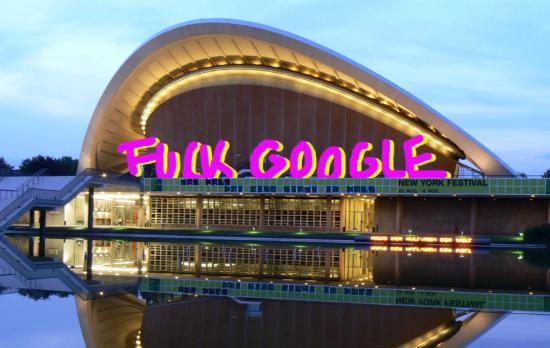
Not necessarily trying to be a definitive solution against the big G in any sense of the word, but more a reminder, a provocative virus to diffuse. So we have a graffiti firefox skin, fuck google pins, The F.A.T Pad or some plugins to reclaim your public individual space on your browser. Everything is D.I.Y and opensource, so you can easily replicate it. The approach can be find with FuckFlickr a free image gallery script offering everyone who visits a Flicker-like image gallery.

The F.A.T. Lab is an example of technological sabotage. Of course, it’s not a new thing in respect of the hacker community: using the instrument, medium directly, in order to change perceived assumptions of our reality. What is quite new is F.A.T. Lab’s blatant exploitation of everyday Pop culture and its language. The hacker counterculture has always had it’s own way of communication, built in the late 80’s and 90’s. These days, more and more people use the computer, not just hackers. Using Pop culture in order to communicate one’s message could be one possible way to escape the duality culture/counterculture. On the other hand, F.A.T. Lab could be creating a fresh paradigm which allows others who would not normally appreciate hacker culture or even media art culture, filling a space beyond art culture which could be considered as too refined.
Marcello & Gaia: Can you describe who you are and how do you connect each other?
Evan Roth from F.A.T. Lab: We are a group of friends. There’s not any formal application process or open call, many come from typical art organizations. It started out as a group of friends and then slowly, more friends joined. We also made more friends, collaborators on line. Here at Transmediale.10, it’s actually our first chance to meet face to face and some of us have not met before. There are two things that mainly characterize us. On one side, there is the open source culture and advertisement free culture, but also the idea that this all should be fun. Art and political activism doesn’t have to be a boring, the interface of it all, can be accessible to more people. We try to push this candy coding, get the those audiences who are using youtube videos, that is our primary audience. We like it when art organizations pay attention to us but really our main audience is at the borders of things, using different networks, commercial networks out there, happening outside of the gallery.
M&G: If we look at the projects you are showing here there is a kind of aesthetic in common, the colours are really interesting, the pink and the yellow remind us early 90’s spam. Is that aesthetic a primary decision, is the style you choose to define you, or has it just happened in the progress of your work.
E: I answer that in two. There is a thing from open source development culture that is ‘release early and release often’, we try to apply this model to the media production. We try to release ‘early and often’. If you are on the fence where you should release something or not and it is not quite ready, just push out the door, because it is better to have it in the public counter system than not. So the aesthetic of the website is in part probably pushing out the door rather taking care of the nuances or the color it is. We just try to get this thing published quickly. Someone could be sitting on their brilliant idea and waiting for years to release, waiting for some details and then you find that no one really cares about this in the end. But there is also an aesthetic interest in common, that comes from this ‘dirty style’. There is an artist friend, Cory Arcangel who is one of my favorites, and he describes the dirty style as ‘either you take little interest in design so it becomes so un-aesthetic or you over-work it to a point that the work itself becomes something too trivial’. We don’t have meetings about how the website is going or what it looks like.
M&G: Don’t you think that this “dirty style” is somehow hiding the real content or the message? The use of ‘dirty style’ is obviously an answer of the hyper sensibilization, concern of the form but at the same time this makes your work splitting in between the no-attention of form and pushes content in the corner.
E: The way our websites look matter’s less and less now, because people don’t go to websites for content anymore. Most of the traffic in the websites do not even see the pink and the yellow, design. There is some kind of form/function relationship going on. We are interested in rolling up this web 2.0 idea a little bit, and that’s what this installation here is about at Transmediale. The early 90’s aesthetic was with people hand coding html and making tables, not downloading a WordPress thing. In that sense, there is a sort of connection to the DIY, rolling back to the way of 1.0 – where the files are hosted in your own server and not google or yahoo.
M&G: Isn’t it more interesting to try and critique in a more constructive way, creating something else, not just another google appropriation but other kind of net platform for a community? Could that be one of the important challenges for artists now?
E: Open source is a big movement and free culture is even bigger and so we know that there are people out there hacking in this way right now, but we are not programmers, there are programmers taking part but these are not our skills. Our place in this movement is in the media side. We do have programmers in our group but we feel more like media makers. We make these videos and they are kind of funny and taking something from the pop/culture, twisting them, possibly people have a look and pass them around. But there are messages in them. And the messages are trying to reveal the money and the branding business that google is making and saying it is not cool, and being involved in an alternative open source culture looks better. We also have a development tool like fuck flicker and flv player where you can have your own videos up like you tube.
M&G: Why are you are supposed to win this year’s Transmediale? You stood up on the stage during the award claiming the award for yourselves!
E: Oh no, we don’t think we are supposed to win. Do you know Kanye West? This is a USA story, we joked about Kanye a little bit. We’re always trying to pay attention to what is going on in pop culture and surf a little bit. Kanye was notorious for interrupting a ceremony whenever he lost, grabbing the mic. As we were for this fuck google project – last night, the winner was a youtube related project, and google is a sponsor. The message we tried to get across last night, was a reference to this, and we are gonna have an official press release on it soon. But I think that for Transmediale, our project was an anomolie, showing this fuckgoogle in contrast to accepting web 2.0, which is actually a range of projects. We were surprised to be invited, who know’s what for? But we think that it was a very wise decision, and we are really happy to be here.
On their website you can get a clear impression of their feelings towards Google “So, what is so “fuck-worthy†about Mother-google? It is the fact that a corporate entity, even one as beloved and competent as Google, is in control of such a large stake in the digital network and public utility upon which we have all grown so reliant. And, that as a publicly traded company, it doesn’t have to answer to anyone but its largest shareholders, despite the fact that its decisions effect the lives and private information of millions of people. Few even question or raise a voice in opposition to the Google-ification of the Internet.”
There were more than 1,500 submissions for the Transmediale.10 awards, nine art projects were nominated and F.A.T. Lab was a runner up amongst them. Showing contemporary, activist art within a larger more incorporated festival is to be commended, it is not an easy thing to do. And we all know how easy it is to criticize rather than make something ‘real’ and positive happen. F.A.T. Lab are a tangible byproduct of a culture, caught in the trappiings of Hyperreal situations, a confused world losing itself even further into a perpetual state of denial. Pop culture and celebrity related banalities are constantly distracting our gaze. It is an interface which can only handle life via mediated proxy. F.A.T. Lab know’s this, and have adapted themselves to literally scrap with it on their own terms. Their role and place in the world is to get out there on the front line and go places where the common people reside. They want to be on the main stage battling it out, whilst challenging the interface presented to us all – making it their playground.
You can also read Marcello Lussana and Gaia Novati’s article about this year’s Transmediale.10 here…
Mark Napier’s Venus 2.0
Angela Ferraiolo
February 5, 2010
“Now that I’m done’ I find the artwork disturbing. It freaks me out. Maybe I’ll do landscapes for a while to detox.” — Mark Napier
Artist Mark Napier, well-known for the net classics Shredder, Riot, and Digital Landfill, recently exhibited his latest work Venus 2.0 at the DAM Gallery in Berlin. A sort of portrait via data collection Venus 2.0 uses a software program to cross the web and collect various images of the American television star Pamela Anderson. These images are then broken up, sorted by body parts put back together and — as this inventory of fragments cycles onscreen, a leg, a leg another leg — the progressive offset of each rendering of Anderson’s head, arms, and torso makes her reconstructed figure twist, turn and jerk like a puppet. It’s odd looking. Even her creator is a little afraid of her:
“I have to say’ if I ever meet Pamela Anderson in real life I think I’ll completely freak out and run away. I don’t think I could have a conversation with the woman after this project … I started with a sympathetic view of the actual Pamela Anderson. She is part of the spectacle of sexuality in contemporary media. She’s caught in that ‘desiring machine’ as much as any other human’ probably even more so. She has surgically modified her body in order to have greater leverage in the media. Does this put her in control? I think not.”
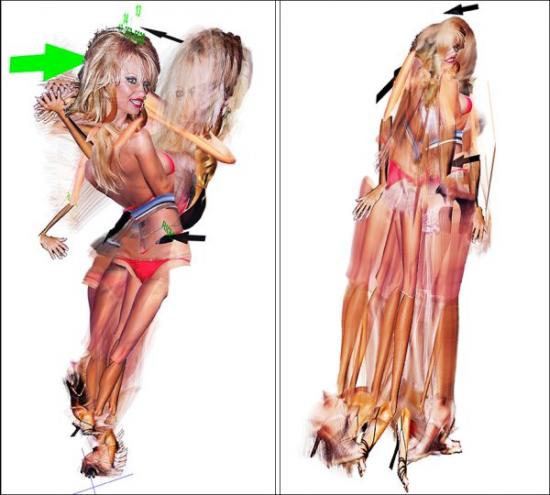
Napier’s project doesn’t answer or intend to answer the question of who is in control either, but it plays with the possibilities. Although I wasn’t able to see the portrait at its exhibition. I did track down part of the series Pam Standing at a private location here in New York. Napier has also posted video excerpts of the work online. Unfortunately, these still images and clips are a bit too static to really do the piece justice. If you get to see the real thing and if you look for a while, you’ll see what I mean. Venus 2.0 is an amazing jigsaw puzzle, a deceptive surface of shifting layers – part painting and part search result.
The effect is translucent, lyrical, mathematic and creepy. When I implied that it must have taken an awful lot of precision and calculation to get something like this to come together, Napier insisted that focusing on the technology behind Venus 2.0, its algorithm, or even on the unique materiality of networked art in general, is a way of missing the point. The way he relates to Venus 2.0 is through the painter’s hand. What counts is not the data feed, but who were are, what we want and how we behave:
“The artwork is a riff on sexuality as an elaborate hoax played by a precocious molecule that builds insanely complex sculptures out of protein, aka, meat puppets or more simply, ‘us’. These animate shells follow a script that’s written and refined over the past half billion years. And that script is in a nutshell: 1) survive 2) reproduce 3) goto #1. So sexual attraction is the carrot to DNA’s stick. Attraction is part of the machine. In art history this appears as the tradition of Venus. And more recently: Duchamp’s ‘Bride’. Magritte’s ‘Assasin’. Warhol’s ‘Marilyn’. The focus of digital art is still the human being. Don’t be distracted by the gadgets.”
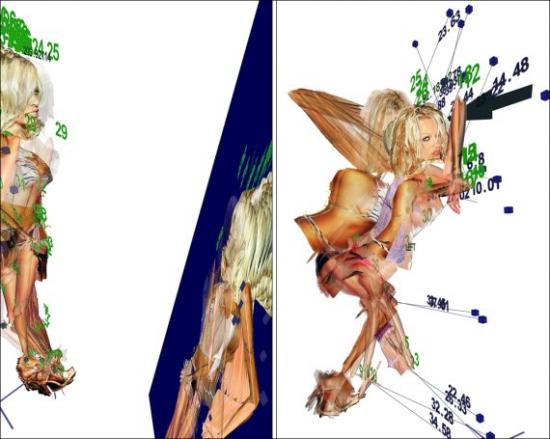
Hi-tech or not, new media artists are by now well-practiced in the technique of unraveling a familiar image to expose an occluded, yet equally valid identity. In Distorted Barbie, Napier relied on a repeated process of digital degradation to blur both the literal and conceptual fiction of the Mattel franchise. Another early project stolen, took the female body apart, presenting attraction as database. Years later these kind of approaches, pixel manipulations and indexing without comment, as well as parsing and remixing have become a sort of standard operating procedure in new media. So much so that as technique becomes more well-known and more accessible, it can be hard to tell one work from another or one artist from the next. With this in mind’ it seems important to note that in the case of Venus 2.0 it is not so much a choice of subject or an organizational scheme that guarantees the final effect, but the manner in which Napier investigates the image and the ways in which Napier illustrates and manipulates both the visual elements of portraiture and his relationship to the figure involved.
Napier builds and destructs, assembles and tears apart, but in doing so tries his best to keep us focused on these activities as processes. At times Pam’s contortions are allowed to expose the wireframe which allegedly guides her construction and at certain key points on the interface, there is also a steady stream of vector coordinates to embody the idea of data. But Napier makes less of technology than another artist might by effacing what some would tend to elaborate on, in order to draw our attention elsewhere – usually towards evolution, gradation and the ways in which images evolve, and by extension the ideas that inspire those images which reflect how unstable elements are, even treacherous:
“I work at probabilities: what is the likelihood that the figure will be totally opaque? How often does it get murky and undefined? How often should I let that happen and for how long? How often does the figure jump? How long till the figure lands and stands up again? How much time is spent in chaotic motion and how much in stillness? How often does something completely messy happen? Like the figure gets tangled up in a ball that has no structure. I don’t know how the piece will play out each minute, but I know what kind of situations will arise in the piece. I can plan those likelihood, and then let the piece play and see what it does.”
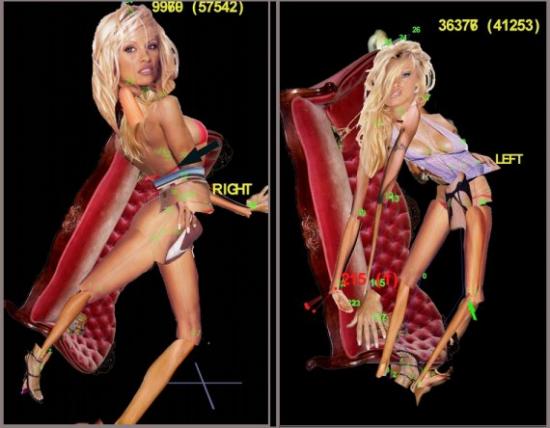
So, like the woman who inspired her. Pam Standing is beautiful, but more unsettling. What makes Pamela Anderson the most frequently mentioned woman on the Internet? Why do we mention her? What is it we want when we give our gaze to celebrity? What has celebrity done to attract us? Whatever your answers, what Napier privileges in his response is not a fixed portrait of a star, but a cloud of iteration that produces its own image and reproduces that image, jangled, confused and full of surprises. A portrait whose finest moments are accidental and whose design is an accumulation of fragments that tense and dissolve, floating like clouds one instant and then sinking like lead the next. This is where the imagination takes a step forward and Napier the artist or Napier the geek becomes Napier the puppetmaster, a networked Dr. Coppelious:
“My favorite moment with the PAM series was when I finally got all the math to work so that the body part images displayed correctly and the correct side of the body showed at the right time and the stick figure suddenly started to look like a ‘real’ puppet that was starting to come alive in the golem-esque way that I thought it could when I was sketching out the idea. I had that Dr. Frankenstein moment: ‘She’s aliiiiiiiiiive!!!!!!!!!!!!!’ which was really the point all along, to create this virtual golem that is clearly not alive at all and yet teases us all with this false appearance of life. Venus 2.0.”
Until the layers of arms, legs, breasts and hips collapse in on themselves and Pam is back where she started, a manipulated beauty unable to escape presentation as a collaged monstrosity.
Note: Mark Napier has been creating network art since 1995. One of the earliest artists to deal thematically and formally with the Internet, Napier has been commissioned to create net art by the Solomon R. Guggenheim Museum and the San Francisco Museum of Modern Art. His work has appeared at the Centre Pompidou in Paris’ P.S.1 New York’ the Walker Art Center in Minneapolis’ Ars Electronica in Linz’ The Kitchen’ Kunstlerhaus Vienna’ ZKM Karlsruhe’ Transmediale’ iMAL Brussels’ Eyebeam’ the Princeton Art Museum’ la Villette’ Paris’ and at the DAM Gallery in Berlin.
Arriving at the homepage of Ten Thousand Cents, an Internet artwork by Aaron Koblin and Takashi Kawashima, a mottled image of a one hundred dollar bill slowly fades into view. Ben Franklin looks out sedately. Mousing over the large image, the cursor is replaced with a small red rectangle. And here lays the beauty of the project; with the click of each rectangle, a zoomed in portion of the one hundred dollar bill is revealed. On the left side is a high-resolution photograph of that tiny portion of the bill. On the right side, a real-time moving image plays, revealing how the image was drawn by a human hand in a drawing program created by Koblin and Kawashima. There are, in fact, 10,000 such rectangles and each was created by a Turker through Amazon’s Mechanical Turk marketplace.
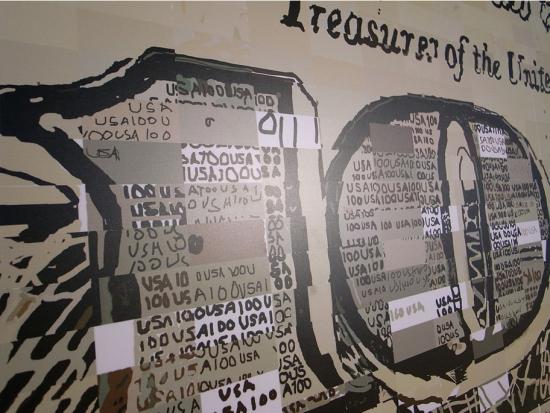
Over the course of five months (from November 2007 to March 2008) Koblin and Kawashima posted tasks, known as HITs, Human Intelligence Tasks, on Amazon’s Mechanical Turk site. Having broken down an image of a one hundred dollar bill into 10,000 sections, Turkers were tasked with redrawing their assigned section. Each Turker was paid $.01 for the task, making the total payment of drawing a one hundred dollar bill one hundred dollars. (Prints of the project can also be bought for one hundred dollars. All proceeds are donated to the One Laptop per Child (OLPC) project) Each Turker worked anonymously, unaware that what they were drawing was a section of a bill or that their work would eventually be combined with other Turkers’ work to create an art project. The variability is endless. Some Turkers methodically draw in the lines and painstakingly shade in boxes. Some quickly slash the paint tool across the page; one imagines they felt they had better things to do with their time. Some are cheeky, using the space for digital graffiti or messages like “I love U.” Most copy the image exactly. Yet, with the differing movements and tempos, every one suggests a different story and different person behind the tool. I suggest you take a few minutes and watch the unfolding scenes. They are oddly, satisfyingly banal and beautiful.
The project and its presentation on the website are undoubtedly elegant. Yet, the conceptual work behind the piece is a bit murkier. The project description states, “The project explores the circumstances we live in, a new and uncharted combination of digital labor markets, ‘crowdsourcing,’ ‘virtual economies,’ and digital reproduction.” Big and important themes. What are the implications of crowd-sourcing for creative work? For any kind of paid work? Where is the distinction between work and play? Creativity and re-presentation? In this deeply networked age, what are the evolving relations between individual and collective action?
The Mechanical Turk, made by Wolfgang de Kempelen in 1769, caused a sensation in 18th and 19th century Europe, first for its existence as a seemingly intelligent chess playing automaton – one who could beat Ben Franklin and even Napoleon in chess – and subsequently, for being an infamous hoax. Inside of the automaton was in fact a man, a skilled chess player. The Mechanical Turk was no thinking machine. It was an elaborate performance of concealment and human skill.

In 2005, in an ironic (and some might say distasteful) turn of events, Jeff Bezos of Amazon named a new business venture, Amazon Mechanical Turk. The idea was to make a digital marketplace that capitalized on the unique intelligence of human agents. Broken down into microtasks, known as HITs, Mechanical Turk provides a means to accomplish those tasks that humans can do quickly but which would take computers much longer to do, for instance, tagging images, taking surveys or transcribing audio recordings. This Mechanical Turk is also a performance of human skill, one that revels in its basis in human intelligence – Bezos calls it “artificial artificial intelligence” – but one that also operates within a mode of concealment and indeed, alienation.
As Katharine Mieszkowski of Salon wrote about Mechanical Turk in 2006, “There is something a little disturbing about a billionaire like Bezos dreaming up new ways to get ordinary folk to do work for him for pennies.” Critics of Mechanical Turk abound, and their objections point to the insidious labor relations that Mechanical Turk enforces, implying that Mechanical Turk approaches a virtual sweatshop. The system was designed for employers, not employees. The earnings of Turkers fall within a gray area of digital labor, officially being classified as contractor work, subject to high self-employment taxes and no option for benefits. Although a rating system protects employers, in so far as employers can choose to reject a work offer from a Turker or refuse to pay a Turker if the work is completed unsatisfactorily, no such system protects Turkers. As advocates of a Turker Bill of Rights have pointed out, there is no effective outlet within Mechanical Turk for Turkers to voice grievances against employers. What does exist is a vibrant community forum, Turker Nation, where Turkers advise each other on known scammers.
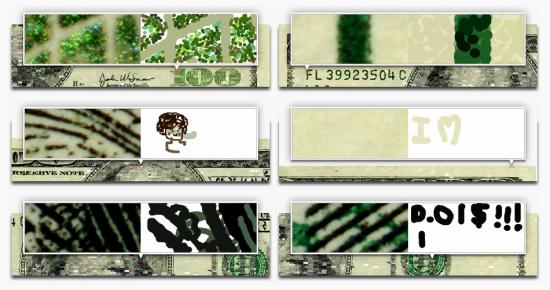
Moreover, although anecdotally Mechanical Turk is understood as more game or past-time than employment, a recent study out of University of California, Irvine’s Informatics Department points out that almost a third of Turkers rely on Mechanical Turk as a source of income. Another study found that nearly half of Turkers report their motivation for working as income related. For this population of Turkers, it is troubling to consider the possibilities of exploitation and unfair labor practices.
In this light, I find the artists’ neat appropriation of the mechanisms of Mechanical Turk unsettling. The implications and the stakes of Mechanical Turk as an economic system are left untouched. And considering that the artists chose to create a representation of money and employ Turkers, these dimensions of economy and labor are present but disappointingly unaddressed.
Yet, the moments in the project that remain in my mind’s eye like lovely specters as I glance at the dollar bill that I traded for coffee this morning, are the movements of the individuals who drew each section. On this level, the project is like a fantastic cabinet in which each drawer opens onto a new wonder. Perhaps what Ten Thousand Cents effectively offers is not a statement about labor politics or late capitalism’s continuing ability to provide structures for domination and exploitation. Perhaps Ten Thousand Cents asks us to take a different step toward understanding “the circumstances we live in,” revealing the endless variability of individual expression. In this networked age, we often act collectively, that is, together, parallel, most often without knowledge of the larger directions toward which our actions will lead. Collaboration, laboring together, is notion whose meaning is expanding and changing in the 21st century. What remains, even among protocols and code, is individuality. Though we are subsumed by larger structures, we do have spaces for self-expression and self-formulation. Leave an exploration of the limits of these spaces to others – and I surely believe we must consider the limitations. Yet we must also explore and value the spaces of possibility and the domains where we are active agents. We are called to remember that every artifact is irreducible to its mere instance in the world – it is a sum of processes and individual actions.
Of course, “the circumstances we live in” also requires us to keep in mind the bottom line. It’s all about the Benjamins, as the phrase goes. In response to a HIT, no less, requesting an answer to the question, “Why do you complete tasks in Mechanical Turk” one Turker wrote, “I do it for the money!”